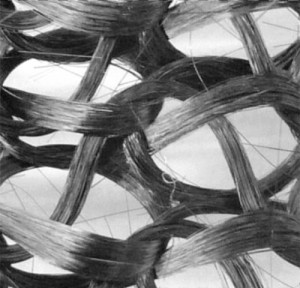Home > Press > How to Knit Carbon Fibers
 |
Abstract:
Textile structures made from silicon carbide fibers are very interesting for manufacturing of fiber reinforced high temperature resistant ceramic matrix composites (CMC) materials. To produce such textile structures a one or multi-step manufacturing processes like braiding, weaving, warp, or weft knitting is necessary. Depending on the fiber packing density and orientation the fabric structure, the stiffness, deformation, and fracture behavior of the fabric structure vary in a wide range.
How to Knit Carbon Fibers
Germany | Posted on April 12th, 2012In contrast to woven fabrics, which exhibit a low drapability and stretchability in different directions, warp-knitted fabrics are formed by creating loops which give rise for high flexibility and deformability. However, a high Young's modulus and low deformability of the carbide fibers makes loop formation during knitting difficult. Bending of fibers is also affected by the friction which is caused by ribbing between fibers and the machine parts and by the friction between the fibers inside the roving.
Recently, scientists from the Friedrich-Alexander-University Erlangen-Nuremberg, Germany, demonstrated the manufacturing of knitted fabrics made of silicon carbide fiber. They derived the critical bending loads from fiber knot and loop testing in order to optimize yarn pretension, working speed, and take up speed during knitting processing. Subsequently, they tested and examined the mechanical behavior of the knit fabric under tensional load.
The investigations show that fiber fracture during knitting can be caused by torsion, bending, or tension. The German researchers considered fiber bending as the critical loading condition imposing boundary condition on the knitting process. Reduction of inter fiber friction surface sizing was found to be a critical step in order to produce a continuous knit structure.
The scientists modified the processing conditions for knitting and reduced buckling and friction acting on the silicon carbide fiber rovings. Using penetrating oil the points of largest friction between fibers and critical knitting elements were lubricated which decreased fiber fracture. Compared to woven silicon carbide fabric structures the knitted fiber perform offers a superior flexibility, wider range of pore size and a higher degree of drapability.
####
For more information, please click here
Copyright © How to Knit Carbon Fibers
If you have a comment, please Contact us.Issuers of news releases, not 7th Wave, Inc. or Nanotechnology Now, are solely responsible for the accuracy of the content.
| Related Links |
![]() Link to the original paper on Wiley Online Library:
Link to the original paper on Wiley Online Library:
| Related News Press |
News and information
![]() Researchers develop molecular qubits that communicate at telecom frequencies October 3rd, 2025
Researchers develop molecular qubits that communicate at telecom frequencies October 3rd, 2025
![]() Next-generation quantum communication October 3rd, 2025
Next-generation quantum communication October 3rd, 2025
![]() "Nanoreactor" cage uses visible light for catalytic and ultra-selective cross-cycloadditions October 3rd, 2025
"Nanoreactor" cage uses visible light for catalytic and ultra-selective cross-cycloadditions October 3rd, 2025
Discoveries
![]() Researchers develop molecular qubits that communicate at telecom frequencies October 3rd, 2025
Researchers develop molecular qubits that communicate at telecom frequencies October 3rd, 2025
![]() Next-generation quantum communication October 3rd, 2025
Next-generation quantum communication October 3rd, 2025
![]() "Nanoreactor" cage uses visible light for catalytic and ultra-selective cross-cycloadditions October 3rd, 2025
"Nanoreactor" cage uses visible light for catalytic and ultra-selective cross-cycloadditions October 3rd, 2025
Announcements
![]() Rice membrane extracts lithium from brines with greater speed, less waste October 3rd, 2025
Rice membrane extracts lithium from brines with greater speed, less waste October 3rd, 2025
![]() Researchers develop molecular qubits that communicate at telecom frequencies October 3rd, 2025
Researchers develop molecular qubits that communicate at telecom frequencies October 3rd, 2025
![]() Next-generation quantum communication October 3rd, 2025
Next-generation quantum communication October 3rd, 2025
![]() "Nanoreactor" cage uses visible light for catalytic and ultra-selective cross-cycloadditions October 3rd, 2025
"Nanoreactor" cage uses visible light for catalytic and ultra-selective cross-cycloadditions October 3rd, 2025
Textiles/Clothing
![]() Protective equipment with graphene nanotubes meets the strictest ESD safety standards March 25th, 2022
Protective equipment with graphene nanotubes meets the strictest ESD safety standards March 25th, 2022
![]() Polymer fibers with graphene nanotubes make it possible to heat hard-to-reach, complex-shaped items February 11th, 2022
Polymer fibers with graphene nanotubes make it possible to heat hard-to-reach, complex-shaped items February 11th, 2022
![]() Flexible material shows potential for use in fabrics to heat, cool July 3rd, 2020
Flexible material shows potential for use in fabrics to heat, cool July 3rd, 2020
|
|
||
|
|
||
| The latest news from around the world, FREE | ||
|
|
||
|
|
||
| Premium Products | ||
|
|
||
|
Only the news you want to read!
Learn More |
||
|
|
||
|
Full-service, expert consulting
Learn More |
||
|
|
||








